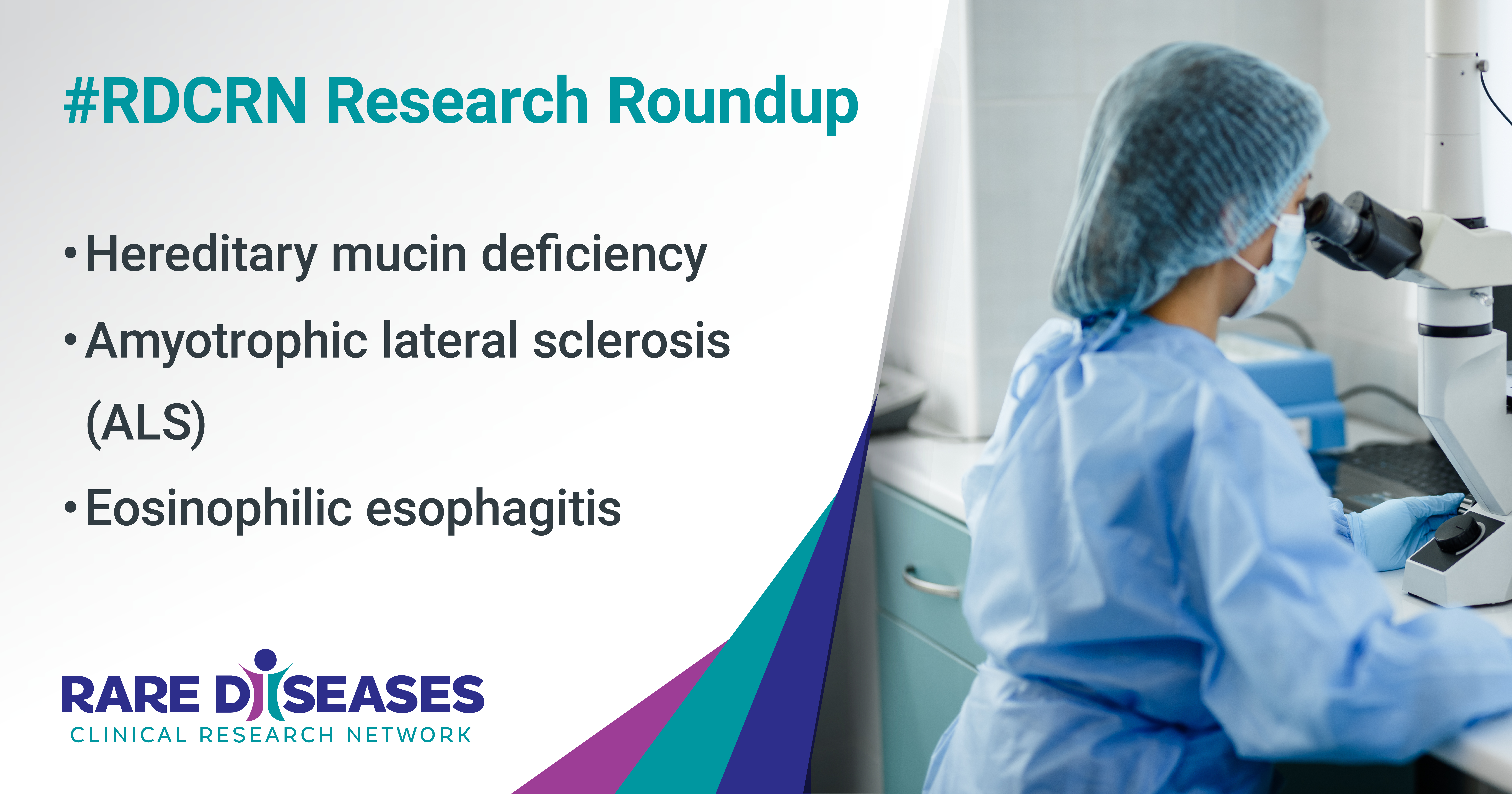Each week, we share summaries of recent Rare Diseases Clinical Research Network (RDCRN) grant-funded publications. Read new research on hereditary mucin deficiency, amyotrophic lateral sclerosis (ALS), and eosinophilic esophagitis.
Congenital Absence of MUC5B Defines New Category of Genetic Respiratory Disease
Genetic Disorders of Mucociliary Clearance Consortium (GDMCC): Hereditary Mucin Deficiency Caused by Biallelic Loss of Function of MUC5B
Mucins (the major protein component of mucus) are fundamental to airway health. Upregulation of mucin 5B (MUC5B) is observed in common lung diseases, making it a potential therapeutic target. In mice, Muc5b is required for mucociliary clearance and for controlling inflammation after microbial exposure, although the consequences of its loss in humans are unclear.
In this study, researchers aimed to identify and characterize a family with congenital absence of MUC5B. The team performed whole-genome sequencing in an adult proband, deep phenotyping, and genotyping with reverse phenotyping for 8 family members. Across accessible sample types, the team performed immunofluorescence staining and mass spectrometry for mucins.
Results show that congenital absence of MUC5B defines a new category of genetic respiratory disease. In addition, the human phenotype is consistent with the Muc5b mouse model. Authors note that further study of individuals with decreased MUC5B production could provide unique insights into airway mucus biology.
A Roadmap to ALS Prevention: Lessons from Pre-Symptomatic ALS and Other Neurodegenerative Diseases
Clinical Research in ALS and Related Disorders for Therapeutic Development (CReATe): Preventing amyotrophic lateral sclerosis: insights from pre-symptomatic neurodegenerative diseases
Significant progress has been made in understanding the pre-symptomatic phase of amyotrophic lateral sclerosis (ALS). Much is still unknown, however, and advances in other neurodegenerative diseases—including Alzheimer's disease (AD), Parkinson's disease (PD), Huntington's disease (HD), spinal muscular atrophy (SMA), and frontotemporal dementia (FTD)—highlight opportunities for discovery in ALS.
This article builds on discussions at the First International Pre-Symptomatic ALS Workshop (January 2020, Miami, Florida). Lessons from AD illustrate the importance of conceptualizing neurodegenerative diseases as biological entities. PD and HD, respectively, highlight the value of prodromal clinical markers and the value of tools to predict age of onset. FTD elucidates nuanced differences in pre-symptomatic disease based on genotype, and SMA underscores the value of early therapeutic intervention.
The authors discuss a conceptual framework for pre-symptomatic ALS that includes clinically silent and prodromal stages of disease. They also provide recommendations for the study of motor, cognitive, and behavioral manifestations of early ALS; emphasize the critical importance of biomarkers; discuss the challenges of genetic and biomarker counseling as well as a range of ethical, legal, and social issues relevant to pre-symptomatic disease. Last, but not least, they present ideas about the design of early intervention and disease prevention clinical trials. Ultimately, the authors present a road map to early intervention—and perhaps even disease prevention—for all forms of ALS.
Close Follow-Up Benefits Long-Term Management of Eosinophilic Esophagitis
Consortium of Eosinophilic Gastrointestinal Disease Researchers (CEGIR): Close follow-up is associated with fewer stricture formation and results in earlier detection of histological relapse in the long-term management of eosinophilic esophagitis
Eosinophilic esophagitis (EoE) is characterized by immune cells called eosinophils building up in the esophagus, which may cause polyps, tissue break down, inflammation, and ulcers. The follow-up schedule for maintenance treatment of EoE varies, possibly due to a lack of a recommended schedule.
In this study, researchers analyzed "close follow-up" (less than 18 months between maintenance visits) and "non-close follow-up" (greater than or equal to 18 months between maintenance visits) for steroid treatment of EoE. They found that close follow-up was associated with less stricture formation (abnormal narrowing) and earlier detection of EoE relapse by histology.
Authors note that regular assessment of EoE disease activity (every 12-18 months) may be beneficial in detecting relapsing disease as early as possible, therefore potentially minimizing the risk for EoE complications.
The Rare Diseases Clinical Research Network (RDCRN) is funded by the National Institutes of Health (NIH) and led by the National Center for Advancing Translational Sciences (NCATS) through its Division of Rare Diseases Research Innovation (DRDR). Now in its fourth five-year funding cycle, RDCRN is a partnership with funding and programmatic support provided by Institutes, Centers, and Offices across NIH, including the National Institute of Neurological Disorders and Stroke, the National Institute of Allergy and Infectious Diseases, the National Institute of Diabetes and Digestive and Kidney Diseases, the Eunice Kennedy Shriver National Institute of Child Health and Human Development, the National Institute of Arthritis and Musculoskeletal and Skin Diseases, the National Heart, Lung, and Blood Institute, the National Institute of Dental and Craniofacial Research, the National Institute of Mental Health, and the Office of Dietary Supplements.


